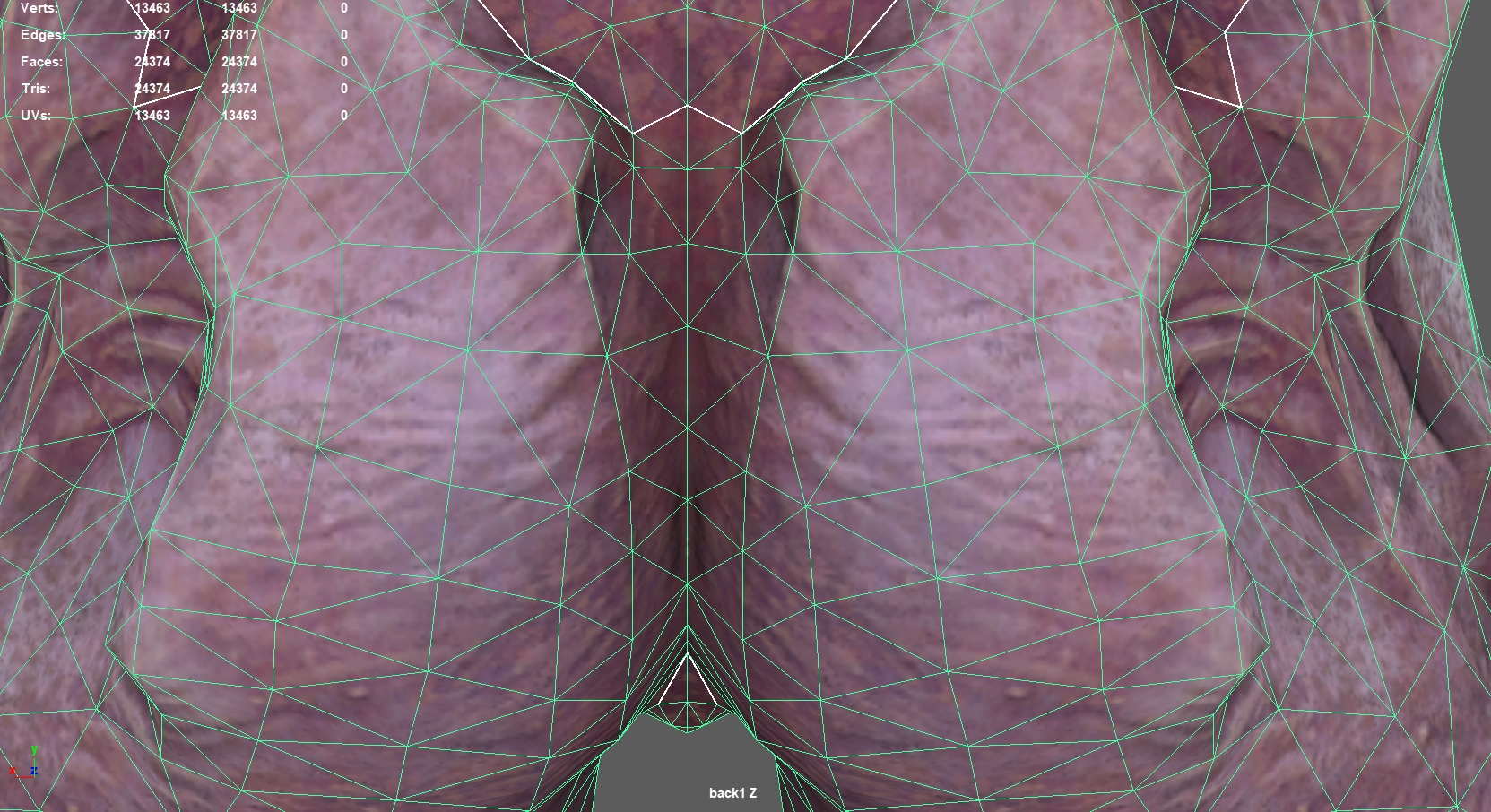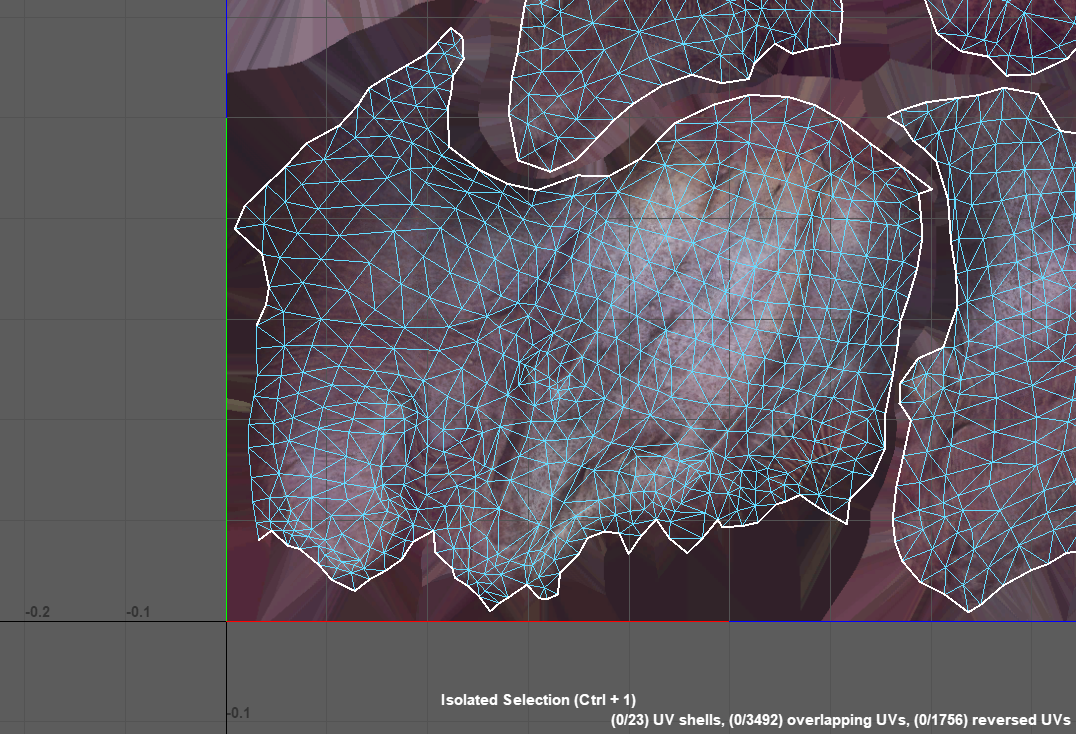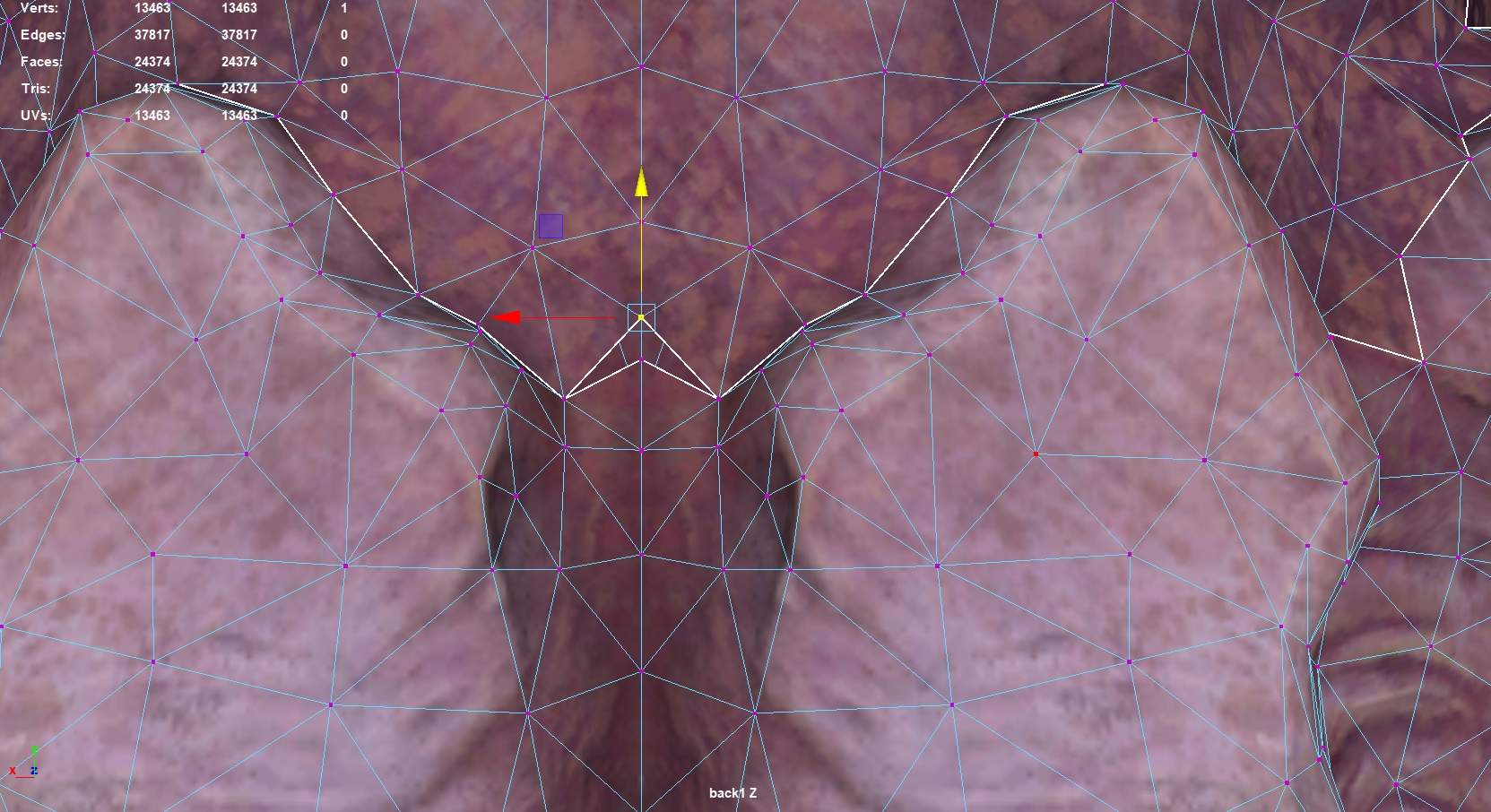What's happening here and is this common practise...?
Hi
I came across something strange whilst examining how the Hell Knight model from Doom Eternal was unwrapped. I swear I may have come across this before and possibly asked about it...? I'm not quite sure how this works. But also, is this common practise...?
Around the butt area, the top, bottom, and around the upper leg has cuts, but there's nothing there straight down the crack.

Hovering over the shell or selecting it, selects both sides of the upper leg. However, when looking at the unwrap itself, the far left side has no white line indicating there's a cut.

Moving the UV shell doesn't reveal a mirrored shell underneath either. So somehow both sides are overlapping...? But I don't understand how there's no cut down the crack/middle. I did notice the top and bottom cuts are not welded though, so I'm not sure if that's related. And if it is, how that works.

So if someone could shed some light on this, it would be much appreciated.
Thanks
I came across something strange whilst examining how the Hell Knight model from Doom Eternal was unwrapped. I swear I may have come across this before and possibly asked about it...? I'm not quite sure how this works. But also, is this common practise...?
Around the butt area, the top, bottom, and around the upper leg has cuts, but there's nothing there straight down the crack.

Hovering over the shell or selecting it, selects both sides of the upper leg. However, when looking at the unwrap itself, the far left side has no white line indicating there's a cut.

Moving the UV shell doesn't reveal a mirrored shell underneath either. So somehow both sides are overlapping...? But I don't understand how there's no cut down the crack/middle. I did notice the top and bottom cuts are not welded though, so I'm not sure if that's related. And if it is, how that works.

So if someone could shed some light on this, it would be much appreciated.
Thanks
Replies
I'm wondering if it was done deliberately. A thought did cross my mind though, which I might have to try... I'm wondering if the other side was mirrored/overlayed, maybe even had each point snapped over the shell below, and then the left side/edge was re-welded but without doing an Unwrap/Unfold afterwards...?
It most likely just got borked during an import/export process - how did you get the model?
I found it on DeviantArt. Loads of people manage to rip the models from PS4 games. Managed to do it myself with Elden Ring as well. Super useful to use the models for reference.
But yes, unwrapping one half and then adding symmetry would've been much easier. ^^; Welding the centre line afterwards would've yielded the same results lol
There's a world of difference between best practices and recommendations which can only be generic, and the specifics of a given model developed under (also very specific) circumstances.
This is obviously a "one off" model. This is completely different from a model made to be modular or destined to be a basis for others. And then there's always the possibility that it was done by an external vendor. Just looking at it won't tell you much - if anything it could very well be breaking the best practices supposedly used on this project, but got shipped anyways because ... reasons.
Similarly you'll never get a clear cut answer on a topic like that butt seam being welded on itself on the ripped model. Just looking at the model will never tell you the whole story about how it got made - even more so after it going through multiple exports and rips.
For instance, a vendor not following the tech bible of this project may have decided on their own to "harden all UV islands" (like many still blindly do, even though it makes zero sense and is just a misunderstanding that has been sticking around for more than 10 years now). If that happened the team then had no other choice than going along with it since welding/smoothing would require a rebake or a somewhat delicate normal map transfer.
And then the engine and/or the model ripper might treat hard edges as splits, since from the GPU perspective they are the same thing.
Lastly, even though stacking mirrored pieces instead of cleanly offsetting them is definitely bad practice, it doesn't necessarily justify wasting hours to get it edited by a team member who probably has better things to do. All that to say that no, you can't necessarily infer "100% good practices" just by looking at model rips. Especially since the engine may have its own quirks one may not be aware.
- - - - -
Also, the thread is somewhat hard to follow as these two screenshots are from different models. So I suppose you're branching off to a different question here about the angled pieces.
Based on my research before I started my own version, I believe the model was made by Jason Martin who works at id Software. I even remember asking him a few questions at one point, such as the dorsals of the feet/legs being based on that of a dog.
https://www.artstation.com/believerdeceiver
To be fair, I could ask him, but there's no guarantee he'll respond. He didn't to the last message I sent. :-\
Oh, and I was taught that by a lecturer.
The same is true for the other topics about the UVs and edges.
You'll end up constantly running in circles if you keep hoping to extract some kind of absolute gospel exclusively from either or. That's just not the way things work. On top of that, the fact that a model is greenlit to ship says nothing about it 100% adhering to some nebulous "best practices" or even to the tech bible of the studio.
The lecturer mentioning that it is best to lay things straight (and perhaps even insisting that models should be treated that way for a given assignment) was *not* making an inaccurate statement. The inaccurate thing would be to hear it as "all UVs absolutely have to be straight, all the time, for all models, always !"
OUCH!
"Hard UV shells - do you mean assigning different smoothing groups (in max terms) for each shell? Vertices are already separated there GPU-wise so what's the harm in separating smoothing groups too?"
Of course I won't blame you for asking a question, but this kind of "what's the harm" stance backed by some largely irrelevant tech justification is precisely how misinformation and bad practices spread, and how a project can end up with a convoluted (and sometimes straight up broken) pipeline. Because what is missing here is the experience of actually crafting organic models.
In some abstract theory land one could argue that "it doesn't matter, math is just math, the normalmap will be calculated to match anyways". But in practice that would introducing infinitely hard edges on the surface of something that is supposed to be perfectly smooth, and then asking for a normalmap to compensate for something it shouldn't have to (and breaking down catastrophically as texture resolutions gets lowered). Not to mention that some bakers may split the direction of the cast rays according to the mesh normals.
In context, a hand for instance would end up like the mess shown on the right here (and then requiring for the 3D lead to step in and waste a day to smooth out everything, rebake the asset and update/reintegrate multiple files - if that is even possible)
The right side is obviously bad practice.
The only reason I can think of why some people still do this after 10+ years of the baking workflow being the norm, is because they misunderstand the following : *if* a model has a hard edge somewhere (for whatever justified reason), *then* this edge needs to be a split on the corresponding UVs layout because otherwise it would create a bleed of opposide normalmap values over the edge, hence broken shading.
BUT no, each UV island 👏 absolutely 👏doesn't 👏 need to be hardened. And as shown above this isn't just a mere personal preference, as doing so can have practical, bad consequences on the final asset and shipped product. And that's probably the one thing that would deserve to be "hammered in" once and for all ...
@Neox
This genuinely made me laugh out loud
So yeah it is something that, for some reason, some people weirdly believe has to be done even though it is absolutely shouldn't be - especially on organic models.
(BTW quoting whole messages in replies makes the thread very tedious to read)
Having "less wavy" normals has advantages besides just aesthetics. It works way better when you are using same textures for LODs. Yes, obviously it will be bad since map was baked for different geo, but wavy version would look noticeably worse even at a distance where your LODs kick in. Normal baked to lowpoly with hard-shells might compress better and also would have less issues with skewing.
I don't understand example with hands. Isn't those just low poly meshes without normal maps? If so, then right one is only a mess if it's unintentional.
The example with the hands is really as straightforward and self-evident as it can be. If a modeler on a team made the model the way shown on the right, for a bake supposed to capture smooth skin/organics, it simply would have to be redone after removing these hard edges because they are not only unnessary, but actually detrimental to the pipeline and to the look of the asset once in game. Because if the engine scales down the textures for memory/performance needs (or to port the game to lower specs), then all of the sudden some infinitely hard edges would appear in the middle of a smooth organic model. This is *never* desirable. Ever. And making a normalmap work harder than it needs (smoothing out an infinitely hard edge put there for no reason) is completely backwards.
And perhaps things are getting lost in translation too. "Each UV island doesn't need to be hardened" (true) is NOT the same statement as "UV islands should never be hardened" (false).
The thing you mention about avoiding waves (like at the meeting of two sharply connecting concave surfaces) is a completely different story. Because when that is the case, the order of events is the other way around : the hard edges are placed where needed by design for very good reasons first ; and then UVs are crafted accordingly, making sure that every proactively hard edge placed on the model is a split of islands in the UVs (to avoid any bleeding of values over the edge). This is of course completely correct and desirable.
Just give it a bit more though and test it out with practical examples and it'll make sense.
TLDR : the hand example on the right illustrates what happens when people decide for no reason to "harden all UV islands" on something like a smooth organic character or even the barrel of a firearm. This is obviously terrible practice that only comes from a deep misunderstanding of the above topic.
Now to be fair I would agree that this does indeed require a bit of thought as well as some practical experience to wrap one's head around it ! But at the same time this really isn't anything new, and it becomes really quite self-evident when working on models with smooth parts - like as said the limbs of a character body or the cylindrical barrel of a gun ...
As far as I am concerned the only situation where I would consider the bruteforce approach of "let's harden all UV islands because reasons" to be an option ... would be if a pipeline was requiring it for some obscure broken reason than never got fixed. Or, if external vendors (them again !
Thanks
Please re-read my posts above carefully, and also please manipulate actual model examples like a hand or a an analog to that spherical grenade/vial thing. As only thinking about these things will not get you very far - it just has to be manipulated to be grasped.
In the case of the hand, it wouldn't matter at all (outside of preferences/practicality of course) if the UVs where made as two islands, or made of a single piece "joined at the hip" (like a butterfly/rug pelt or an open book as you said), or made of 12874525 pieces.
What matters is that hard edges (I'll avoid using the term Smoothing Groups, as SGs are just a different Max UX to achieve exactly the same thing : edges selectively marked as hard for shading) are to be designed first, placed as needed in order to accommodate a later clean baking and separation of surfaces as well as sharps changes in surface direction. And then the unwrap is done accordingly, making sure that any edge that was set to sharp becomes a split - and the rest is just unwrapped like any other model would be. Not the other way around. As said, there is not a single reason for a hard edge to appear on a smooth sphere or along the side of a cylinder (whether it corresponds to a UV island border or not). There just isn't.
Also ... there's really no such things as "before" or "after" unwrapping. Modeling and unwrapping are not two things that happen separately in succession like the bullet points of video tutorial from a 3d kiddie. They inform each other. Just like how texturing doesn't really come "after" the unwrap : the unwrap is done with texturing in mind.